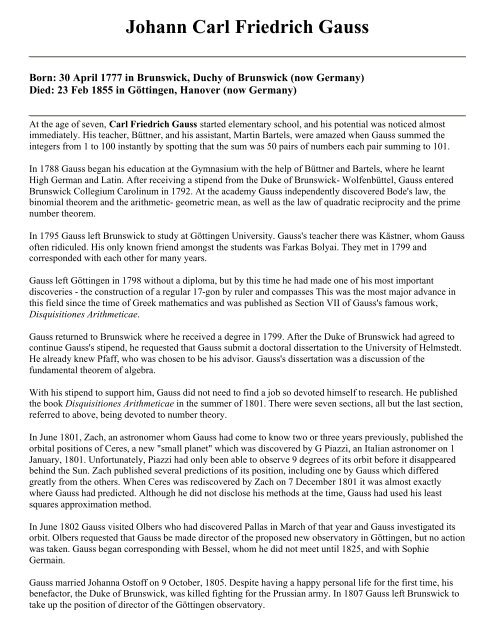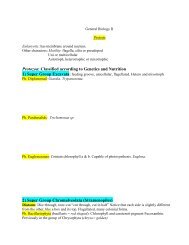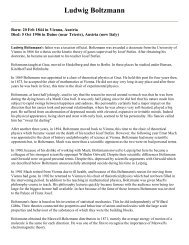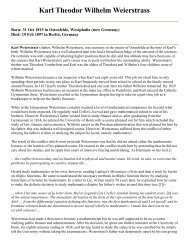Johann Carl Friedrich Gauss
Johann Carl Friedrich Gauss
Johann Carl Friedrich Gauss
Create successful ePaper yourself
Turn your PDF publications into a flip-book with our unique Google optimized e-Paper software.
<strong>Johann</strong> <strong>Carl</strong> <strong>Friedrich</strong> <strong>Gauss</strong><br />
Born: 30 April 1777 in Brunswick, Duchy of Brunswick (now Germany)<br />
Died: 23 Feb 1855 in Göttingen, Hanover (now Germany)<br />
At the age of seven, <strong>Carl</strong> <strong>Friedrich</strong> <strong>Gauss</strong> started elementary school, and his potential was noticed almost<br />
immediately. His teacher, Büttner, and his assistant, Martin Bartels, were amazed when <strong>Gauss</strong> summed the<br />
integers from 1 to 100 instantly by spotting that the sum was 50 pairs of numbers each pair summing to 101.<br />
In 1788 <strong>Gauss</strong> began his education at the Gymnasium with the help of Büttner and Bartels, where he learnt<br />
High German and Latin. After receiving a stipend from the Duke of Brunswick- Wolfenbüttel, <strong>Gauss</strong> entered<br />
Brunswick Collegium Carolinum in 1792. At the academy <strong>Gauss</strong> independently discovered Bode's law, the<br />
binomial theorem and the arithmetic- geometric mean, as well as the law of quadratic reciprocity and the prime<br />
number theorem.<br />
In 1795 <strong>Gauss</strong> left Brunswick to study at Göttingen University. <strong>Gauss</strong>'s teacher there was Kästner, whom <strong>Gauss</strong><br />
often ridiculed. His only known friend amongst the students was Farkas Bolyai. They met in 1799 and<br />
corresponded with each other for many years.<br />
<strong>Gauss</strong> left Göttingen in 1798 without a diploma, but by this time he had made one of his most important<br />
discoveries - the construction of a regular 17-gon by ruler and compasses This was the most major advance in<br />
this field since the time of Greek mathematics and was published as Section VII of <strong>Gauss</strong>'s famous work,<br />
Disquisitiones Arithmeticae.<br />
<strong>Gauss</strong> returned to Brunswick where he received a degree in 1799. After the Duke of Brunswick had agreed to<br />
continue <strong>Gauss</strong>'s stipend, he requested that <strong>Gauss</strong> submit a doctoral dissertation to the University of Helmstedt.<br />
He already knew Pfaff, who was chosen to be his advisor. <strong>Gauss</strong>'s dissertation was a discussion of the<br />
fundamental theorem of algebra.<br />
With his stipend to support him, <strong>Gauss</strong> did not need to find a job so devoted himself to research. He published<br />
the book Disquisitiones Arithmeticae in the summer of 1801. There were seven sections, all but the last section,<br />
referred to above, being devoted to number theory.<br />
In June 1801, Zach, an astronomer whom <strong>Gauss</strong> had come to know two or three years previously, published the<br />
orbital positions of Ceres, a new "small planet" which was discovered by G Piazzi, an Italian astronomer on 1<br />
January, 1801. Unfortunately, Piazzi had only been able to observe 9 degrees of its orbit before it disappeared<br />
behind the Sun. Zach published several predictions of its position, including one by <strong>Gauss</strong> which differed<br />
greatly from the others. When Ceres was rediscovered by Zach on 7 December 1801 it was almost exactly<br />
where <strong>Gauss</strong> had predicted. Although he did not disclose his methods at the time, <strong>Gauss</strong> had used his least<br />
squares approximation method.<br />
In June 1802 <strong>Gauss</strong> visited Olbers who had discovered Pallas in March of that year and <strong>Gauss</strong> investigated its<br />
orbit. Olbers requested that <strong>Gauss</strong> be made director of the proposed new observatory in Göttingen, but no action<br />
was taken. <strong>Gauss</strong> began corresponding with Bessel, whom he did not meet until 1825, and with Sophie<br />
Germain.<br />
<strong>Gauss</strong> married <strong>Johann</strong>a Ostoff on 9 October, 1805. Despite having a happy personal life for the first time, his<br />
benefactor, the Duke of Brunswick, was killed fighting for the Prussian army. In 1807 <strong>Gauss</strong> left Brunswick to<br />
take up the position of director of the Göttingen observatory.
<strong>Gauss</strong> arrived in Göttingen in late 1807. In 1808 his father died, and a year later <strong>Gauss</strong>'s wife <strong>Johann</strong>a died after<br />
giving birth to their second son, who was to die soon after her. <strong>Gauss</strong> was shattered and wrote to Olbers asking<br />
him to give him a home for a few weeks,<br />
to gather new strength in the arms of your friendship - strength for a life which is only valuable because it<br />
belongs to my three small children.<br />
<strong>Gauss</strong> was married for a second time the next year, to Minna the best friend of <strong>Johann</strong>a, and although they had<br />
three children, this marriage seemed to be one of convenience for <strong>Gauss</strong>.<br />
<strong>Gauss</strong>'s work never seemed to suffer from his personal tragedy. He published his second book, Theoria motus<br />
corporum coelestium in sectionibus conicis Solem ambientium, in 1809, a major two volume treatise on the<br />
motion of celestial bodies. In the first volume he discussed differential equations, conic sections and elliptic<br />
orbits, while in the second volume, the main part of the work, he showed how to estimate and then to refine the<br />
estimation of a planet's orbit. <strong>Gauss</strong>'s contributions to theoretical astronomy stopped after 1817, although he<br />
went on making observations until the age of 70.<br />
Much of <strong>Gauss</strong>'s time was spent on a new observatory, completed in 1816, but he still found the time to work<br />
on other subjects. His publications during this time include Disquisitiones generales circa seriem infinitam, a<br />
rigorous treatment of series and an introduction of the hypergeometric function, Methodus nova integralium<br />
valores per approximationem inveniendi, a practical essay on approximate integration, Bestimmung der<br />
Genauigkeit der Beobachtungen, a discussion of statistical estimators, and Theoria attractionis corporum<br />
sphaeroidicorum ellipticorum homogeneorum methodus nova tractata. The latter work was inspired by<br />
geodesic problems and was principally concerned with potential theory. In fact, <strong>Gauss</strong> found himself more and<br />
more interested in geodesy in the 1820s.<br />
<strong>Gauss</strong> had been asked in 1818 to carry out a geodesic survey of the state of Hanover to link up with the existing<br />
Danish grid. <strong>Gauss</strong> was pleased to accept and took personal charge of the survey, making measurements during<br />
the day and reducing them at night, using his extraordinary mental capacity for calculations. He regularly wrote<br />
to Schumacher, Olbers and Bessel, reporting on his progress and discussing problems.<br />
Because of the survey, <strong>Gauss</strong> invented the heliotrope which worked by reflecting the Sun's rays using a design<br />
of mirrors and a small telescope. However, inaccurate base lines were used for the survey and an unsatisfactory<br />
network of triangles. <strong>Gauss</strong> often wondered if he would have been better advised to have pursued some other<br />
occupation but he published over 70 papers between 1820 and 1830.<br />
In 1822 <strong>Gauss</strong> won the Copenhagen University Prize with Theoria attractionis... together with the idea of<br />
mapping one surface onto another so that the two are similar in their smallest parts. This paper was published<br />
in 1825 and led to the much later publication of Untersuchungen über Gegenstände der Höheren Geodäsie<br />
(1843 and 1846). The paper Theoria combinationis observationum erroribus minimis obnoxiae (1823), with its<br />
supplement (1828), was devoted to mathematical statistics, in particular to the least squares method.<br />
From the early 1800s <strong>Gauss</strong> had an interest in the question of the possible existence of a non-Euclidean<br />
geometry. He discussed this topic at length with Farkas Bolyai and in his correspondence with Gerling and<br />
Schumacher. In a book review in 1816 he discussed proofs which deduced the axiom of parallels from the other<br />
Euclidean axioms, suggesting that he believed in the existence of non-Euclidean geometry, although he was<br />
rather vague. <strong>Gauss</strong> confided in Schumacher, telling him that he believed his reputation would suffer if he<br />
admitted in public that he believed in the existence of such a geometry.<br />
In 1831 Farkas Bolyai sent to <strong>Gauss</strong> his son János Bolyai's work on the subject. <strong>Gauss</strong> replied<br />
to praise it would mean to praise myself .
Again, a decade later, when he was informed of Lobachevsky's work on the subject, he praised its "genuinely<br />
geometric" character, while in a letter to Schumacher in 1846, states that he<br />
had the same convictions for 54 years<br />
indicating that he had known of the existence of a non-Euclidean geometry since he was 15 years of age (this<br />
seems unlikely).<br />
<strong>Gauss</strong> had a major interest in differential geometry, and published many papers on the subject. Disquisitiones<br />
generales circa superficies curva (1828) was his most renowned work in this field. In fact, this paper rose from<br />
his geodesic interests, but it contained such geometrical ideas as <strong>Gauss</strong>ian curvature. The paper also includes<br />
<strong>Gauss</strong>'s famous theorema egregrium:<br />
If an area in E 3 can be developed (i.e. mapped isometrically) into another area of E 3 , the values of the <strong>Gauss</strong>ian<br />
curvatures are identical in corresponding points.<br />
The period 1817-1832 was a particularly distressing time for <strong>Gauss</strong>. He took in his sick mother in 1817, who<br />
stayed until her death in 1839, while he was arguing with his wife and her family about whether they should go<br />
to Berlin. He had been offered a position at Berlin University and Minna and her family were keen to move<br />
there. <strong>Gauss</strong>, however, never liked change and decided to stay in Göttingen. In 1831 <strong>Gauss</strong>'s second wife died<br />
after a long illness.<br />
In 1831, Wilhelm Weber arrived in Göttingen as physics professor filling Tobias Mayer's chair. <strong>Gauss</strong> had<br />
known Weber since 1828 and supported his appointment. <strong>Gauss</strong> had worked on physics before 1831, publishing<br />
Über ein neues allgemeines Grundgesetz der Mechanik, which contained the principle of least constraint, and<br />
Principia generalia theoriae figurae fluidorum in statu aequilibrii which discussed forces of attraction. These<br />
papers were based on <strong>Gauss</strong>'s potential theory, which proved of great importance in his work on physics. He<br />
later came to believe his potential theory and his method of least squares provided vital links between science<br />
and nature.<br />
In 1832, <strong>Gauss</strong> and Weber began investigating the theory of terrestrial magnetism after Alexander von<br />
Humboldt attempted to obtain <strong>Gauss</strong>'s assistance in making a grid of magnetic observation points around the<br />
Earth. <strong>Gauss</strong> was excited by this prospect and by 1840 he had written three important papers on the subject:<br />
Intensitas vis magneticae terrestris ad mensuram absolutam revocata (1832), Allgemeine Theorie des<br />
Erdmagnetismus (1839) and Allgemeine Lehrsätze in Beziehung auf die im verkehrten Verhältnisse des<br />
Quadrats der Entfernung wirkenden Anziehungs- und Abstossungskräfte (1840). These papers all dealt with the<br />
current theories on terrestrial magnetism, including Poisson's ideas, absolute measure for magnetic force and an<br />
empirical definition of terrestrial magnetism. Dirichlet's principle was mentioned without proof.<br />
Allgemeine Theorie... showed that there can only be two poles in the globe and went on to prove an important<br />
theorem, which concerned the determination of the intensity of the horizontal component of the magnetic force<br />
along with the angle of inclination. <strong>Gauss</strong> used the Laplace equation to aid him with his calculations, and ended<br />
up specifying a location for the magnetic South pole.<br />
Humboldt had devised a calendar for observations of magnetic declination. However, once <strong>Gauss</strong>'s new<br />
magnetic observatory (completed in 1833 - free of all magnetic metals) had been built, he proceeded to alter<br />
many of Humboldt's procedures, not pleasing Humboldt greatly. However, <strong>Gauss</strong>'s changes obtained more<br />
accurate results with less effort.<br />
<strong>Gauss</strong> and Weber achieved much in their six years together. They discovered Kirchhoff's laws, as well as<br />
building a primitive telegraph device which could send messages over a distance of 5000 ft. However, this was<br />
just an enjoyable pastime for <strong>Gauss</strong>. He was more interested in the task of establishing a world-wide net of<br />
magnetic observation points. This occupation produced many concrete results. The Magnetischer Verein and its
journal were founded, and the atlas of geomagnetism was published, while <strong>Gauss</strong> and Weber's own journal in<br />
which their results were published ran from 1836 to 1841.<br />
In 1837, Weber was forced to leave Göttingen when he became involved in a political dispute and, from this<br />
time, <strong>Gauss</strong>'s activity gradually decreased. He still produced letters in response to fellow scientists' discoveries<br />
usually remarking that he had known the methods for years but had never felt the need to publish. Sometimes he<br />
seemed extremely pleased with advances made by other mathematicians, particularly that of Eisenstein and of<br />
Lobachevsky.<br />
<strong>Gauss</strong> spent the years from 1845 to 1851 updating the Göttingen University widow's fund. This work gave him<br />
practical experience in financial matters, and he went on to make his fortune through shrewd investments in<br />
bonds issued by private companies.<br />
Two of <strong>Gauss</strong>'s last doctoral students were Moritz Cantor and Dedekind. Dedekind wrote a fine description of<br />
his supervisor<br />
... usually he sat in a comfortable attitude, looking down, slightly stooped, with hands folded above his lap. He<br />
spoke quite freely, very clearly, simply and plainly: but when he wanted to emphasise a new viewpoint ... then<br />
he lifted his head, turned to one of those sitting next to him, and gazed at him with his beautiful, penetrating<br />
blue eyes during the emphatic speech. ... If he proceeded from an explanation of principles to the development<br />
of mathematical formulas, then he got up, and in a stately very upright posture he wrote on a blackboard beside<br />
him in his peculiarly beautiful handwriting: he always succeeded through economy and deliberate arrangement<br />
in making do with a rather small space. For numerical examples, on whose careful completion he placed<br />
special value, he brought along the requisite data on little slips of paper.<br />
<strong>Gauss</strong> presented his golden jubilee lecture in 1849, fifty years after his diploma had been granted by Helmstedt<br />
University. It was appropriately a variation on his dissertation of 1799. From the mathematical community only<br />
Jacobi and Dirichlet were present, but <strong>Gauss</strong> received many messages and honours.<br />
From 1850 onwards <strong>Gauss</strong>'s work was again nearly all of a practical nature although he did approve Riemann's<br />
doctoral thesis and heard his probationary lecture. His last known scientific exchange was with Gerling. He<br />
discussed a modified Foucault pendulum in 1854. He was also able to attend the opening of the new railway<br />
link between Hanover and Göttingen, but this proved to be his last outing. His health deteriorated slowly, and<br />
<strong>Gauss</strong> died in his sleep early in the morning of 23 February, 1855.<br />
Article by: J J O'Connor and E F Robertson<br />
December 1996












![IL PRINCIPE – NICCOLÒ MACHIAVELLI [NA = Norton Anthology ]](https://img.yumpu.com/15277483/1/190x245/il-principe-niccolo-machiavelli-na-norton-anthology-.jpg?quality=85)



